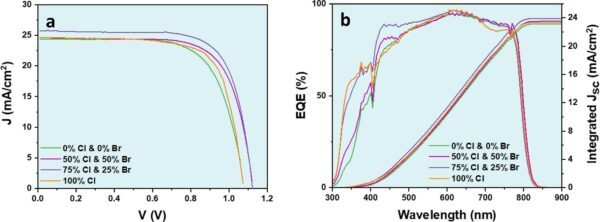Researchers from Australia’s University of New South Wales (UNSW) Sydney have introduced a new defects passivation strategy for chloride-iodide-based perovskite. Corresponding author Ashraful Hossain Howlader told pv magazine that the novel approach improves the cell’s efficiency by about 15%, compared to a control sample, while also making it more environmentally stable.
“Despite promising optoelectronic properties, it is a matter of fact that ion migration is unavoidable in chloride-iodide-based perovskite solar cells due to a radius mismatch between chlorine and iodine,” Howlader and his team explained in the paper. “Local defects like atomic vacancies or accumulation of atoms might occur due to ion migration in chloride-iodide-based perovskite thin film.”
The active perovskite layer in question is made of 60% formamidiunium (FA) and 40% methylammonium (MA), with 10% chlorine (Cl) and 90% iodine (I) used as halide concentrations, for a final formula of FA0.6MA0.4PbI2.7Cl0.3.
Under the active layer, there is a tin oxide (SnoO2) electron transport layer (ETL) deposited on indium tin oxide (ITO) which works as a front electrode. A hole transport layer (HTL) is deposited on top of the absorber based on a perovskite material known as 2,2′,7,7′-Tetrakis-(N,N-di-4- methoxyphenylamino)-9,9′-spirobifluorene. Spiro-OMeTAD was used for the hole transport layer (HTL) and silver (Ag) was deposited as a back electrode.
“From our previous publication, we found a unique phenomenon of self-formation of tin(II) chloride (SnCl2) between the interface of chloride-iodide perovskite and tin(II) chloride (SnO2) ETL,” explained the academics. “During the self-formation process, Sn2+ ions from ETL and Cl- ions from perovskite migrate towards the buried interface. At the same time, we found that I- ions migrate towards the opposite interface. From this phenomenon, it is obvious that the bulk of the chloride-iodide perovskite thin film lacks Cl- and I- ions. Therefore, we need to passivate the bulk of the chloride-iodide perovskite thin film with halogens. At the same time, we also need to passivate the perovskite/ HTL interface.”

Image: UNSW Sydney, Solar Energy, CC BY 4.0
To solve this defect-creating issue, the group deposited two passivators knwon as 4-chlorobenzylammonium chloride (Cl) and 4-chlorobenzylammonium bromide (Br) on top of the HTL. They tested three combinations of the two – 50% Cl & 50% Br; 75% Cl & 25% Br; and 100% Cl & 0% Br – in the above-mentioned cell structure and compared to a control without any passivator.
The 75% Cl & 25% Br was found to be the best performing, with power conversion efficiency (PCE) of 21% at the champion cell, compared to 18.31% of the control cell. The 75% Cl & 25% Br cell showed an open circuit voltage (Voc) of 1.12 V, short-circuit current density (Jsc) of 25.69 mA/cm2 and a fill factor (FF) of 72.78%. The controlled cell performed with 1.06 V, 24.37 mA/cm2, and 70.91%, respectively.
The PCE of the 50% Cl & 50% Br champion cell was 19.81%, while it was 19.23% in the case of 100% Cl & 0% Br. The first had a Voc of 1.12 V, a Jsc of 24.61 mA/cm2, and an FF of 71.80%, while the latter had 1.07 V, 24.67 mA/cm2, and 72.65%, respectively.
“When we compare the stability between two of our cells (control and champion), the samples are tested without encapsulation. We find that the PCE of the control cell can retain about 78% and the champion cell about 88% of their initial efficiencies after about 672 hours,” the scientific group added. “This is due to bulky organic cations at the interface of perovskite/HTL, which protects moisture.”
The results were presented in “Defects passivation in chloride-iodide perovskite solar cell with chlorobenzylammonium halides,” published in Solar Energy.
This content is protected by copyright and may not be reused. If you want to cooperate with us and would like to reuse some of our content, please contact: editors@pv-magazine.com.



By submitting this form you agree to pv magazine using your data for the purposes of publishing your comment.
Your personal data will only be disclosed or otherwise transmitted to third parties for the purposes of spam filtering or if this is necessary for technical maintenance of the website. Any other transfer to third parties will not take place unless this is justified on the basis of applicable data protection regulations or if pv magazine is legally obliged to do so.
You may revoke this consent at any time with effect for the future, in which case your personal data will be deleted immediately. Otherwise, your data will be deleted if pv magazine has processed your request or the purpose of data storage is fulfilled.
Further information on data privacy can be found in our Data Protection Policy.